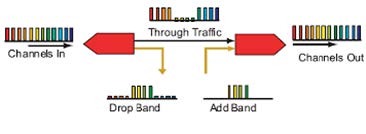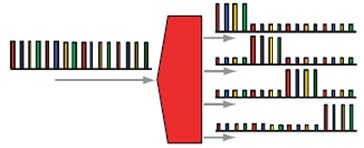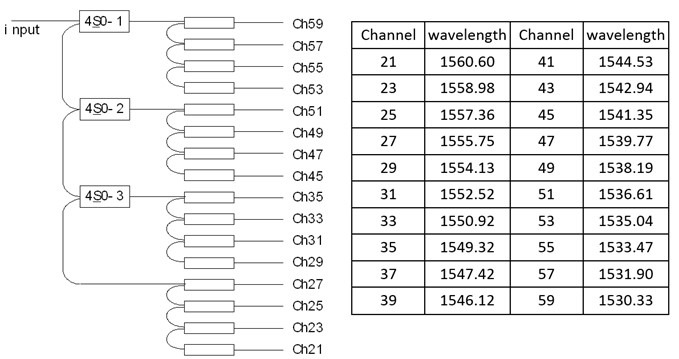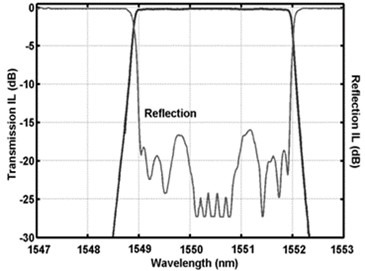By Rebecca Saaltink and Xiaolun Zeng, Iridian Spectral Technologies
Channel skip filters are components added to wavelength division multiplexing (WDM) add/drop modules — in both coarse wavelength division multiplexing (CWDM) and dense wavelength division multiplexing (DWDM) applications — to facilitate band splitting and to manage multiple ITU channels.
These filters feature narrow transitions from pass band to blocking band, minimizing lost channels while maintaining high spectral efficiency (i.e., limiting insertion loss) since the express channels undergo only one reflection.
Channel skip filters are designated in terms of “XskipY,” where “X” represents the channels separated by the filter blocking multiple wavelengths from multiplexed signals, and “Y” represents skipped channels. For example, a 4skip0 filter covers four channels, with all channels accounted for and zero channels being skipped. A 4skip1 filter covers five channels, but one is skipped, meaning its signal is lost.
For a long time, edge pass filters primarily filled this role, despite being limited in that they only permit short wavelength bands or long wavelength bands to pass (while blocking the others). Skip filter technology was available, but its implementation into WDM add/drop modules was prohibitively expensive and its performance was questionable.
With Iridian at the forefront, skip filter technology has evolved over the past 20 years to the point where it presents not only a feasible telecommunications design option but a superior option in terms of yield versus cost.
An Application Example
Consider a DWDM module with one input channel and 16 outputs. Individual bandpass filters, connected one through 16, would accumulate unacceptable insertion loss by the time channel 16 is reached.
Using a channel skip filter — in this case, a 4skip0 filter — module designers can group the three different bands, allowing one band to pass and reflecting the other two. The result, using three 4skip0 filters, is four channel groups. Thus, the final channel (channel 16) accumulates only four channels’ worth of insertion loss, versus the 16 channels’ loss experienced using individual bandpass filters (Figs. 2 and 3).
While the addition of a skip filter does not reduce module cost (as you are adding an additional component or set of components), overall network cost is reduced since the user is able to multiplex more channels down a single fiber optic line. Setups like the one described above would be impossible without the use of channel skip filters, as the last channel would be so polluted with loss, compared to the first channel, that it would not be useful.


Figure 1 – 100 G DWDM band splitter in ADD/Drop module

Figure 2 – The function of three 4skip0 filters combined in 1×16 channel DWDM module

Figure 3 – DWDM 4skip0 filter performance
Choosing Channel Skip Filters Based on Cost-Performance Analysis
Since telecommunication infrastructure budgets rarely are open-ended and network requirements generally are inflexible, designers must balance cost versus performance when integrating channel skip filters.
The first consideration in this equation is base cost related to the number of channels (“X”) a skip filter covers and how many filters will be necessary.
Continuing with the example described above, a designer might opt to use an 8skip0 filter, rather than a trio of 4skip0 filters. While the 8skip0 filter has a higher component cost than a 4skip0 filter, fewer 8skip0 filters would be required for the application.
Part of this consideration also is performance- based, built around how many channels will be allowable per filter while maintaining the module’s necessary performance. A designer would need to ask, “is eight channels’ accumulated insertion loss acceptable for this module (8skip0), or is four channels’ accumulated insertion loss my limit (4skip0)?”
In this same vein, a designer might consider a “skip1” filter. For example, a designer utilizing a 4skip1 filter would lose use of one out of every five channels (20 percent of their network capacity across those channels) at the trade-off of a lower component cost. Conversely, skip0 filters allow designers to regain those lost channels, but at increased component cost.
This decision likely is more critical on long-haul applications, versus metro environments, because in the former, high efficiency carries more significance. Consider that a marine cable may already be sunk, or underground cable installed, so it is vital to make efficient use of all available channels. In local, short-range applications, it may be more cost-effective to simply add more fiber.
Still, this optimization exercise differs from application to application, and designers may find a combination of skip0, skip1, or even skip2 filters best meets their needs.
Finally, a filter’s size must be a designer concern during implementation. In terms of the physical packaging, a skip filter would look the same side-by-side – and take up the same amount of space – as a single-channel filter. The difference is designers need to create room within a module to accommodate additional components when using skip filters, empowering their designs with additional capacity or improved performance across the band as a result.
The ability to customize modules and filter combinations to customer needs is a strength Iridian has developed alongside its filter technologies. Indeed, nearly every application demands a customization to ensure optimal price/performance balance.
For example, two customers might both require 8skip0 filters that cover the same channels, but each customer has different needs for the wavelength range being blocked, the pass bandwidth, the reflect bandwidth, the transmission isolation, and the reflect isolation (Fig. 4). Thus, a standard, off-the-shelf skip filter is unlikely to meet very many customers’ needs.

Figure 4 – Iridian 100 G DWDM skip filters: (L) 100 G 8skip0 – CH36~43, (M) 100 G 8skip1 – CH30~37, and (R) 100 G 8skip1 with extended blocking
Conclusions
While Iridian can tout its experience in meeting the needs of countless customers with similar needs to yours, the word “similar” — particularly when discussing channel skip filter designs — merely denotes that two things are definitively different.
Iridian is skilled in quick customization of components to meet specific customer needs. Standard CWDM and DWDM multichannel separation filter examples are available on our website as a guide for designers, but we have created innumerable specs to meet our customers’ stringent technical and budget demands.
Particularly with skip0 filters, increased steepness can quickly drive up filter cost. Thus, a customer whose application permits a more relaxed roll-off in filter response as frequency changes can reduce costs by ordering a filter, or a combination of filters, customized to that need.
For more information about channel skip filters and how their implementation can serve your project, send us an inquiry. or contact the authors below directly.
About The Authors
Rebecca Saaltink earned a BASc in Engineering Physics at Queen’s University in 2013 and an MSc in Physics from the University of Ottawa in 2016. In 2017, Rebecca joined Iridian Spectral Technologies as an Applications Engineer specializing in telecom filter design with a focus on continued improvement of DWDM filter performance. She can be reached at rsaaltink@idexcorp.com
Xiaolun Zeng holds a B.Eng in automation technology, an MSc. in applied information and computer science, and more than 20 years’ experience assisting customers with a wide range of technology needs for telecommunications applications. Prior to joining Iridian in 2005, Xiaolun served as R&D and sales & marketing manager at Broadex; he also served in senior engineering, product development, and sales roles at AFOP, Santec, and JDS Uniphase. As Account Manager at Iridian, Xiaolun assists telecom customers with optical filter solutions. He can be reached at xzeng@idexcorp.com
Iridian Spectral Technologies Ltd (Iridian) is a diversified optical filter manufacturer that is an international leader in filter design and manufacture especially for application in the fields of fiber optic communications, optical spectroscopy, 3D entertainment, and in aerospace. Iridian is a global supplier with distributors in many countries.


